NAN VANT SOLÈY LA / IN THE BELLY OF THE SUN
Abigail Lucien
August 2021
We’re driving north from Port-Au-Prince. The sun is merciless. A brilliant blanket of heat. No rock, bit of cement, or crackle of dust can escape its reach. We find solace inside the navy-blue tinted belly of a Chevy Suburban – all but shielded from the rays save the front windshield slicing through the ultraviolet light along the mountain side. The nearly vacant landscape could do with a tumbleweed for comic relief.
On the left side of the road in the distance stands a billboard at least twenty feet high and maybe fifty feet long. Our UV slicer steadily approaches and I can make out the words “NEG BANANN” next to a deep skinned man in a navy-blue suit offering an invitational smile through ivory teeth.
This is the first time I lay eyes on Jovenel Moïse.
____
Five years and some change (aka a disputably long presidential term later) all is quiet on the northern shore. The island holds its collective breath. The crows fall silent and the waves crash soundlessly.
Sunday my tonton stands at the mahogany podium where his brother once stood – a foot shorter with the same face. The face of my brother. The face in my own reflection. A face that seasons a mixture of grief and longing and frustration and fortitude to the salt of my tears.
It is the summer of 2021. I’m sitting in a cement courtyard on a white folding chair with the faded initials EEL (Eglise Evangelique Libre) stenciled in red on the back. My homecoming since the passing of my father; one year since the coronavirus stole his flesh body from the waking world; one week since the assassination of our 58th president, Jovenel Moïse.
Tonton’s words reverberate through stacked stereos flanking the caramel tiled stage:
Priye pou fanmiy li.
Priye pou madanm li.
Frè li yo.
Pitit li.
Priye pou tout moun ki konsène nan sitiyasyon an.
Kriminèl yo Ayisyen tou.
____
Yesterday, our first lady, Martine, returned to her country after being hospitalized in Miami. She had been in critical care from multiple gunshot wounds, after her husband was found in their home lying on his back, with blue pants, a white shirt stained with blood, his mouth open, his left eye gouged out, and with twelve large orifices. She stepped onto the tarmac with soft obsidian hair cut close, a black sling cradling her arm, and a matching bullet proof vest hugging her tight. Shades on. An impenetrable stare.
I’m curling the certified UV protection sticker I’ve peeled off my sunglasses between my thumb and index, wondering if I could possibly go without them. In the salon today my sister heard there would be a fait noir tomorrow; a plague of three days of darkness, beginning at noon.
Midday tomorrow comes and the sun does not waver. A WhatsApp message informs my sister the prophecy interpreter got the time wrong and darkness should begin at 8:00PM promptly. We watch the sun sink into the horizon, knowing in our bones its assured return.
____
A BLÒF! A BLÒF! A BLÒF! A BLÒF!
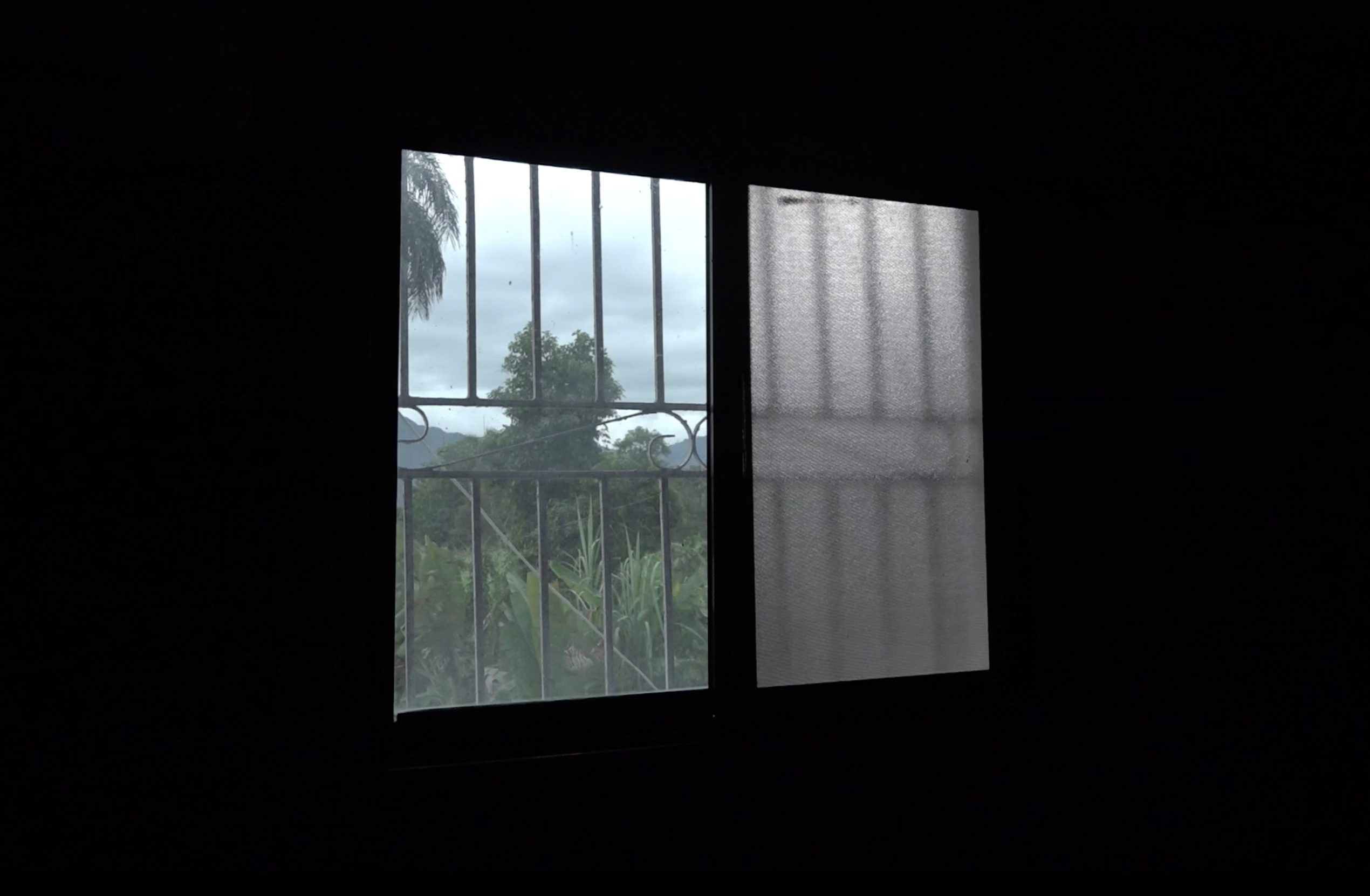
An image taken out the window of my sister’s childhood bedroom at dusk.
I dare imagine what the presidential quarters in Pétion-Ville felt like during the first hours of July 7th. Two partners sleeping back-to-back in the security of one another. The warmth of the Caribbean air cloaking them like a thin linen sheet. A rustle of an impending violence in the bushes.
This is the moment we can all only imagine as we continue to wait for fact to catch up to fiction as our questions continue to be left unanswered. How did a couple dozen Columbian ex-military agents get past national security without a single bullet fired? And if these couple dozen men truly didn’t know they were on an assasination mission, at what point did the truth that they were hired to assist in the killing of a sitting Caribbean president dawn on them?
When the head of the nation called for backup at 1:34am, where was his security? Where was our Haitian national security when our president’s children ran under their bed to hide from a blanket of bullets? At what point did Moïse realize his calls for help would not be answered? The end of the sun’s continued promise of return. A true sans soleil.
YON KOUDETA! YON KOUDETA! YON KOUDETA! YON KOUDETA!
____
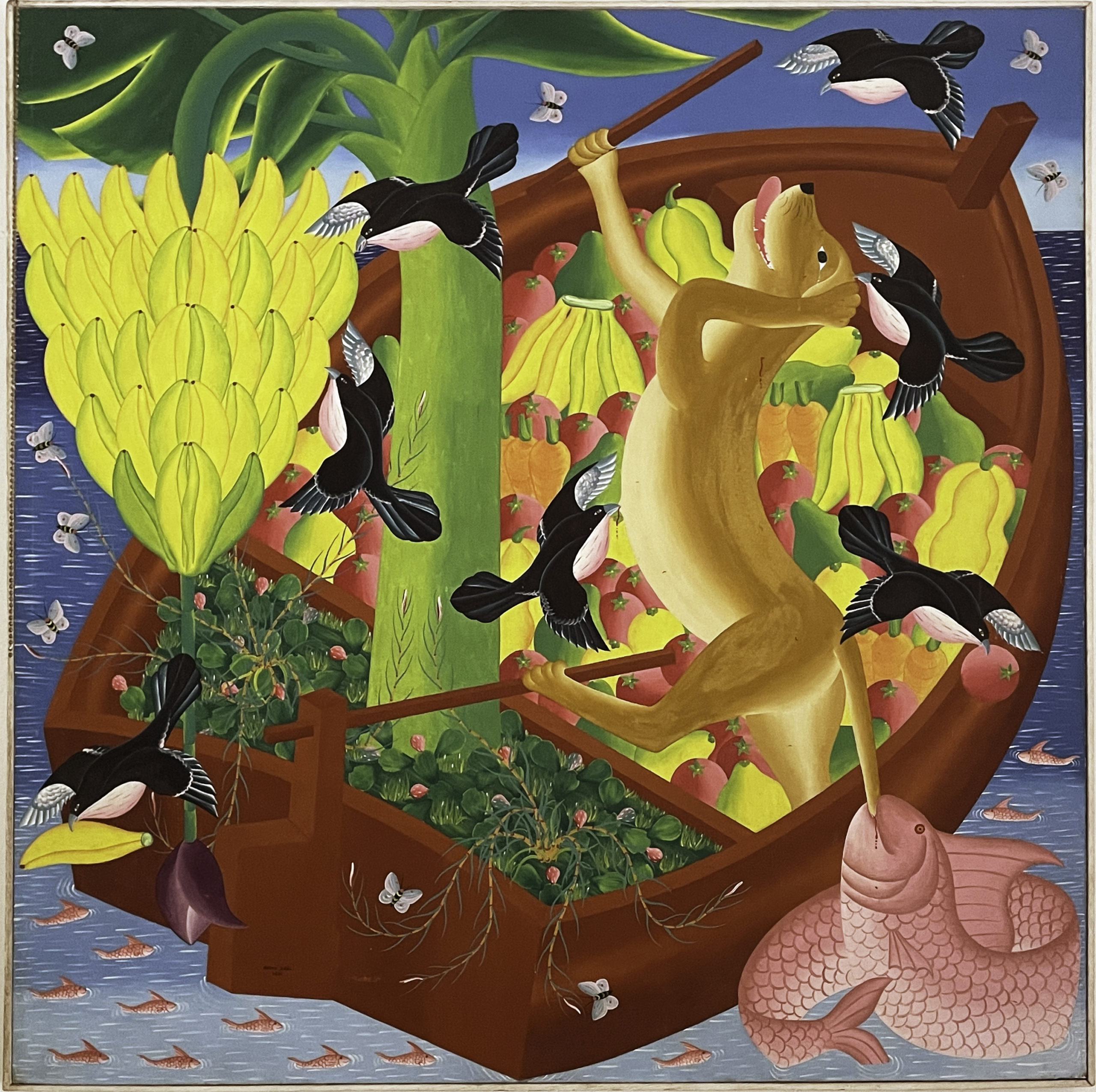
Audes Saül. Unknown title and date. Courtesy of the Gaetjens’ private collection, Cormier/Cap-Haïtien, Haïti. Years ago while cleaning out a storage space in a recently acquired home, the Gaetjen’s family found this painting left behind by the previous home’s owner. It was signed by Audes Saül on the bottom left of the painting with no visible date. After inquiring with the previous owner, the painting was reframed and has hung in the Gaetjen’s family home in Cap-Haïtien ever since.
Suddenly, I see it in the way the morning sun sees liquid encased within the skin of a grape before eventually slurping it raisin-dry. The daybreak illuminates a painting once hidden in the folds of night. As something like four-and-a-half by five feet, how the hell did I not see it before?: a chien payi struggles to guide his boat, full with a fruitful bounty, while assaulted by creatures of the land, air, and sea. His back arches convex, tail pulled taut toward the sea in the bloody bite of a large red snapper who floats on the ocean’s skin.
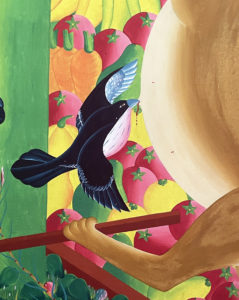
Audes Saül. (painting detail)
The chien’s upper right paw clutches his wooden oar while his left hind leg grasps the rudder to steer. On his face he wears a maniacal grin; a pleasure in his pain or a leading tell of how he’s resourced his bounty. He ferries stolen banann, tomate, kalbas, kawòt, chayote, and zaboka. But not just the fruit, not just the stock to replant, but a whole damn plot of land. A chunk of earth – roots, thorns, cacti, fauna, the whole system. In doing so he has stolen the very fruitfulness the land has to offer. We bear witness to the consequences for his treachery, his judgement carried out by the mercy and vengeance of the fellow creatures of his country.
Seven white-necked crows descend upon him with purpose. Snatching flesh and fruit midflight. Piercing the chien’s belly and head with beak, the crows seize what produce their body will allow them to carry and make off to escape beyond the painting’s borders. Twelve young snappers flank the boat with human-like sneers joining the action like disciples of the sea. Even nine papiyons have swarmed to repossess the very pollen of their land. These creatures mobilize to stop the chien in his tracks and to ensure his return by any means necessary. After all, he too belongs to the country and an escape from the homeland is a dreamy betrayal pondered by many and judged by most. Or is every creature just trying to get something for their own? Where is the force of l’union if everyone is in it for themselves?
So large it goes almost unnoticed, the thick green trunk of a banann tree planted stern side swoops upward into a deep bow to offer its ripe plenty. The symbolic fruit of our fallen president, Neg Banann aka The Banana Man aka his economic promise of national progress through agricultural investment. At the end of the banann cluster a stem droops the tree’s deep purple blossom. A symbol of heritage and humility, a single petal begins to unpeel, foreshadowing the inevitable cycle of all life.
A hummingbird takes sips from flowering banana blossoms. The sound of its wings are drowned out by the sound of a parked truck’s running engine.
____
Now the FUNÉRAILLES NATIONALES DU PRÉSIDENT DE LA RÉPUBLIQUE SEM JOVENEL MOÏSE streams live from Madeline/Cap-Haïtien. We watch from the television screen as the state flag, in all its revolutionary brilliance, drapes the casket, parting it into two swashes of red and blue. It is Friday. The entire island poises on a manchèt’s edge.
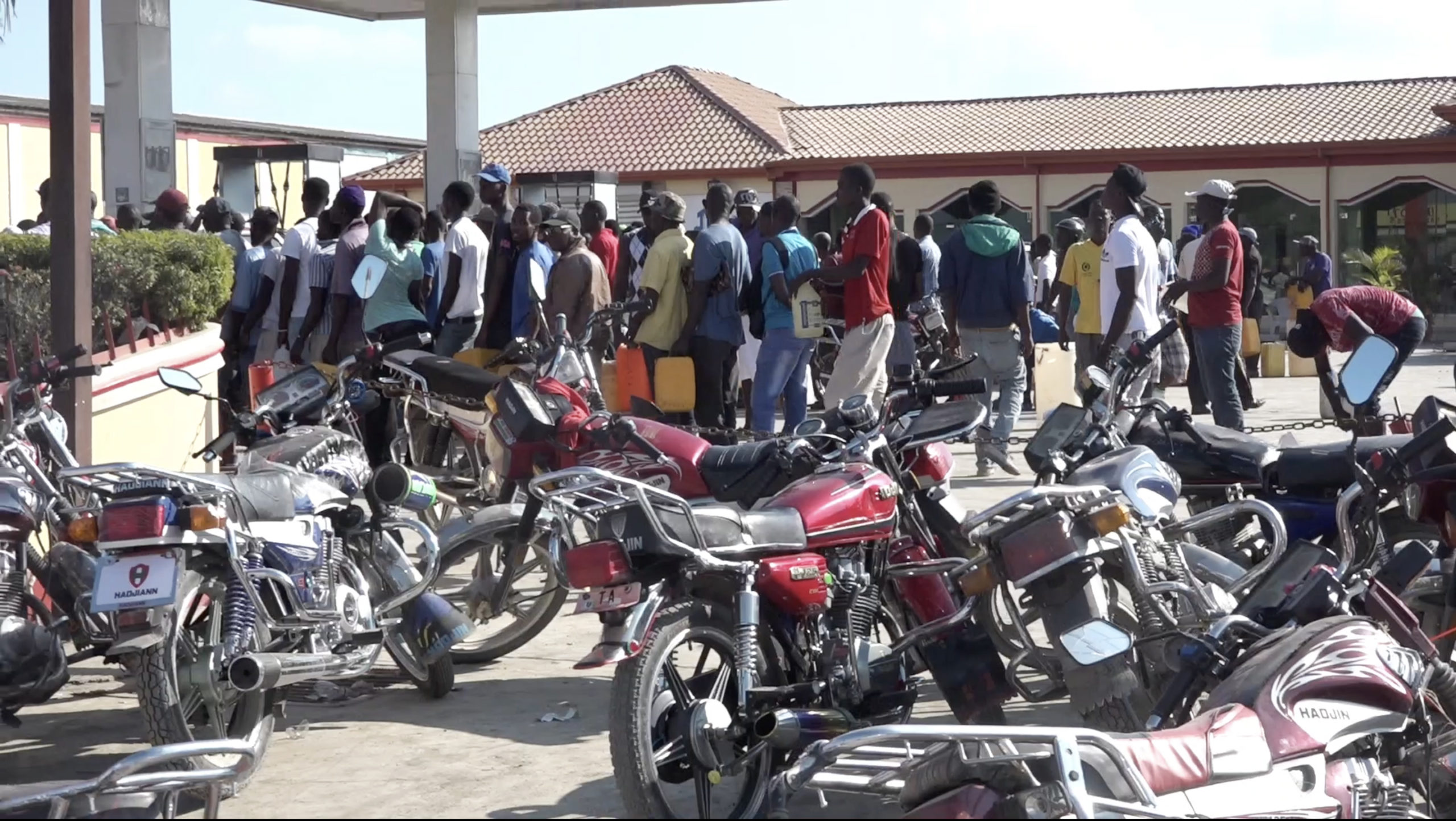
People temporarily abandon their motorcycles and cars to join a line at a gas pump in Northern Haïti. As the country’s gasoline shortage continues to escalate, locals are left with the choice to either wait in line all day with the hope of filling their jugs with gasoline or return home empty-handed. In July 2021, gasoline in Haïti was being sold at an average of $10 USD a gallon.
Spiraling rings of blackened rubber intersect the roads at various points throughout the city: declarations of protest against the southern politicians making their way to Okap for the service. Have you ever seen burnt earth? Burnt rock? Burnt dust? There is nothing for the flame to eat, so it consumes itself: the ash a dry ebony. An unsettling visual of a perplexed eternal end, like how the weight of staying strapped on the day of a funeral fucks with your own perception of death.
It was no secret Moïse did not have the heart of the Haitian people. The man who won his contested election with 55 percent of the votes, in a year of 18 percent of eligible voter turnout, had the years of his leadership notarized by corruption and brutality. Now his removal from office is sharply punctuated by an abstruse coup d’état. The crowd is filled with hundreds of family, friends, associates, white national security reinforcements, French and Canadian ambassadors, wailing bodies in grief, Catholic priests robed in bright purple and gold; a thick irony in the question of how many of those in attendance were involved in the assassination themselves.
Nou pap janm konnen verite de kisa ki te pase nan jou sa. Yet if we ever hope to see a free Haïti, the truth must be illuminated.
Let me be clear here: the Haitian revolution never ended. The one and only successful Black slave revolt could not be met with successful international trade, let alone stable internal infrastructure. A better future looks like a truly independent Haïti – outside of the empirical hold of the United States, outside of the anti-Black legislation of our only bordering nation, way the fuck outside of Western media narratives put in place to uphold power through tactics like giving us the surname of “poorest nation in the Western Hemisphere,” and outside of normalized violence within our own communities that teaches blood killing blood as the only path forward.
I think about my father’s vision of a free Haïti and how he would not live to see it unfold. I want to live to see Haïti become a nation that places Haitian people at its center – for the descendents of those who fought over two centuries ago against white oppressors flourishing in the Black opulence we have always been. I want to see it be both affordable and profitable for agriculture to thrive, for our land to be rich in nutrients, for our babies and for our babies’ babies to plant in the same soil our Taino ancestors tended. For the chiens and crows and snappers and papiyon to come together in a union so strong even the relentlessness of the sun cannot scorch it.
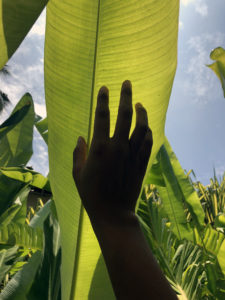
My hand reaching toward the underbelly of a leaf in a field of banann trees. The sun can be seen through the leaf’s translucent green skin.
____
OU PAKA ASSASINE YON PEYI
____
I watch a white-necked crow land on top of a gutter on a nearby building as we are asked to flip to Psalms 144:11. A daughter of a pastor, I don’t own a bible so I Google and follow along: Deliver me and rescue me from the hands of foreigners whose mouths are full of lies, whose right hands are deceitful.
I’m sitting on the same white folding chair, with the same faded EEL stenciled in red on the back, on the same cement courtyard as I did two years ago. Before the dawn of the pandemic. Before the steel supported metal awning stretched to shelter the entire courtyard and its congregation from the beating of the sun.
In the east corner of the courtyard, a fifteen-foot gap between the meeting of two buildings creates a burning corridor for the sun to weaponize its rays. Years before, an old cobalt tarp with an American advertisement for water was strung up taut across the gap by grommets like a thin blue hide of the ocean stretched out to dry. The tarp bore the four-foot face of a white dude, hung upside down, grinning next to the slogan DLO NATIRÈL. VI NATIRÈL. I watched over the years as the man’s face gradually dissolved like a grotesque visualization of an erasure of one’s mind. No one seemed to notice this white man’s intrusion save for the bit of relief he brought from the rising morning.
Even now, the ushers play a choreographed dance with time as a single remaining patch of square light makes its passage through the courtyard. It comes from the same eastern crack as years before. The ushers move one congregation member after another as the square of light falls upon them. Like they’ve been individually selected by the burning star itself.
Bondye itilize nou pou sove peyi a.
Yon prezidan paka ede nou, ni yon gouvènè ni yon nasyon etranje.
Se nou menm ki ka fè sa.
Like clockwork, the folding chairs in my row have danced out of the way, skirting the edges of the persistent sun patch until only I remain sitting at the new edge of the aisle. A runner of light illuminating the imperfections in the cement floor. I feel the sun before I see it. Feel its touch before it lays its hands. A sweltering caress, it has crept to the side of my face licking the very salt it tongues out of my forehead. Soon there will be nowhere to escape. I take a deep breath and allow it to swallow me whole.
For information on where to donate aid to Haïti relief efforts, please see here.
MESI: Thank you to my baby brothers for picking me up from the airport, to my tonton for providing all the protection and care a niece could dream of, to The Luminary for supporting my residence home, to BURNAWAY for the summer-long nurturing, to my sister for hiking up a mountain with me just to get Wi-Fi so I could send a draft to my editor, to my cousin for being my Kreyole bible, to the folks at MARCH for publishing, to the Gaetjens whose painting in their private collection inspired this writing, and to the island and country my heart will always be tethered to.
All photos and videos courtesy of the author.
This essay has been published in partnership with The Luminary as part of their Residency Program.
Abigail Lucien is an artist working in sculpture, language, video, and sound. Raised in Cap-Haïtien, Haiti and the northeast coast of Florida, they miss exchanging cheek kisses and public pools. Lucien is currently based in Baltimore, MD where they teach in the Interdisciplinary Sculpture department at MICA.